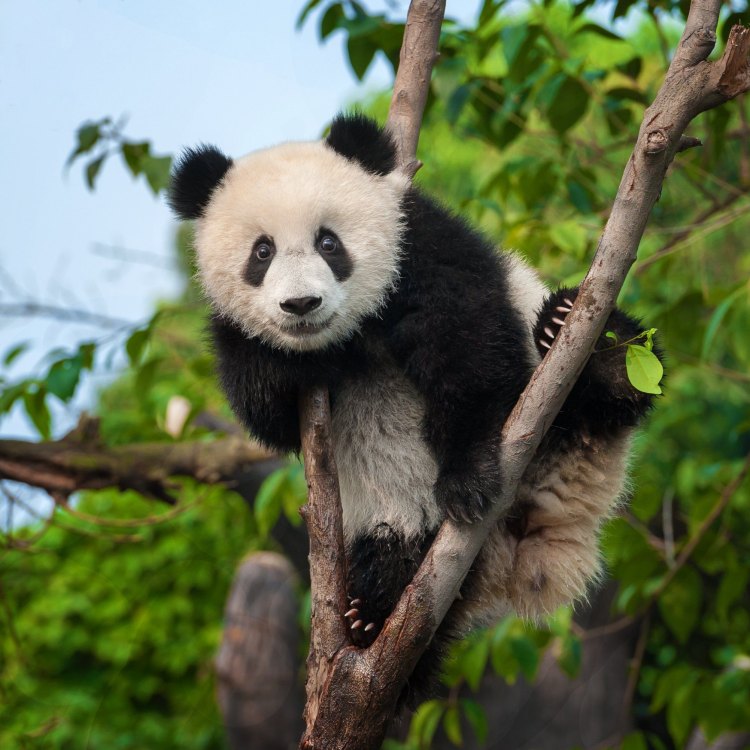
Giant Panda Bear
1.2 to 1.9 meters
The Giant Panda Bear is a beloved and iconic animal native to China, particularly in the provinces of Sichuan, Shaanxi, and Gansu. Known for its distinctive black and white fur and large size, these ursine creatures can grow up to 1.9 meters in length. With their large and robust bodies, Giant Panda Bears are truly a sight to behold in their natural habitat. Keep an eye out for these gentle giants on your next visit to China! #GiantPandaBear #China #Ursidae
Animal Details Summary:
Common Name: Giant Panda Bear
Kingdom: Animalia
Habitat: Temperate forests
The Intriguing World of Giant Panda Bears
Giant panda bears are undoubtedly one of the most beloved and iconic animals in the world. With their adorably fluffy appearance and charming demeanor, it's no surprise that they have captured the hearts of people worldwide. These majestic creatures are known for their distinctive black and white fur, but there is so much more to them than just their striking appearance. In this article, we will take a deeper dive into the fascinating world of giant panda bears Giant Panda Bear.The Science behind the Name
Known to the scientific community as Ailuropoda melanoleuca, the giant panda bear is a unique mammal belonging to the Kingdom Animalia. The name derives from Greek words, with "ailu" meaning cat and "poda" meaning foot, describing the panda's cat-like paws. As for the species name, melanoleuca translates to "black and white" in Latin, aptly referring to the panda bear's striking coloration.A Rare and Protected Species
Sadly, giant panda bears are an endangered species, with only around 1,800 individuals remaining in the wild. They can only be found in the remote mountain ranges of western China, making them incredibly rare and difficult to spot. The main reason for their decreasing population is human activity, such as habitat destruction, poaching, and climate change. However, thanks to conservation efforts and breeding programs, the giant panda population has been slowly increasing in recent years.A Mighty Carnivore
Contrary to popular belief, giant panda bears are not herbivores but rather carnivores. They belong to the order Carnivora, which includes animals such as bears, seals, and skunks Goby Fish. However, they are classified as carnivores with a herbivorous diet, as they primarily feed on bamboo. Bamboo makes up about 99% of their diet, with the remaining 1% consisting of small mammals and birds. This unique feeding method is due to their carnivorous digestive system that is unable to digest the cellulose found in bamboo.A Preferred Habitat
Giant panda bears are native to China and can only be found in the temperate forests of the Sichuan, Shaanxi, and Gansu provinces. These forests provide the ideal environment for them to thrive, with an abundance of bamboo, their primary food source. The forests also offer a diverse range of plant and animal species that help maintain the balance of the ecosystem. However, due to deforestation and urbanization, their habitat is rapidly diminishing, putting these magnificent creatures at risk.A Picture of Elegance
One of the most striking features of giant panda bears is their unique black and white fur coloration. This distinctive color pattern serves as camouflage, making it easier for them to hide in the dense forests. The fur on their face is white, with black patches around their eyes and ears, giving them an adorable "panda eye" appearance. Their bodies are mostly covered in thick fur, with the exception of their legs, shoulders, and a strip around their belly. The fur is so thick that it keeps them warm during the harsh winter months in their mountainous habitat.A Force to be Reckoned With
Giant panda bears may look cute and cuddly, but don't be fooled by their charming exterior. They are powerful and robust creatures that can weigh up to 160 kilograms. Their large and stocky body shape, along with their sharp claws and powerful jaws, make them well-adapted to their carnivorous lifestyle. Despite their fierce appearance, giant panda bears are gentle animals that rarely show aggression towards humans.Size Does Matter
On average, giant panda bears are between 1.2 to 1.9 meters in length, with males being slightly larger than females. These impressive dimensions, combined with their adorable appearance, have earned them the title of "giant" pandas. However, compared to other bears, such as grizzlies or polar bears, they are relatively small. But what they lack in size, they make up for in charm and cuteness.Bound by Family
Giant panda bears are solitary animals, but they do come together during the breeding season. Females give birth to one or two cubs, which are entirely helpless and blind at birth, weighing only 100 grams. The cubs are entirely dependent on their mothers for the first few months of their lives, during which the mother tends to them attentively. However, the bond between mother and cub is short-lived, as the mother will eventually return to her solitary lifestyle, leaving the cub to fend for itself.A Symbol of Hope
The giant panda bear has become a symbol of hope and conservation, not just in China but around the world. Their popularity has helped raise awareness about the importance of preserving endangered species and their habitats. The Chinese government, along with many organizations and individuals, have put in considerable efforts to protect and save these magnificent creatures from extinction.In conclusion, the world of giant panda bears is filled with unique and fascinating features, from their carnivorous diet to their iconic fur coloration. Despite facing numerous threats, these gentle giants continue to capture hearts and inspire conservation efforts worldwide. Let us hope that with continued conservation efforts, future generations will be able to experience the wonder of these majestic creatures in the wild.

Giant Panda Bear
Animal Details Giant Panda Bear - Scientific Name: Ailuropoda melanoleuca
- Category: Animals G
- Scientific Name: Ailuropoda melanoleuca
- Common Name: Giant Panda Bear
- Kingdom: Animalia
- Phylum: Chordata
- Class: Mammalia
- Order: Carnivora
- Family: Ursidae
- Habitat: Temperate forests
- Feeding Method: Carnivorous
- Geographical Distribution: China
- Country of Origin: China
- Location: Sichuan, Shaanxi, and Gansu provinces
- Animal Coloration: Black and white
- Body Shape: Large and robust
- Length: 1.2 to 1.9 meters

Giant Panda Bear
- Adult Size: 120 to 190 centimeters
- Average Lifespan: 20 years
- Reproduction: Sexual
- Reproductive Behavior: Mating season in spring
- Sound or Call: Low-frequency vocalizations
- Migration Pattern: Non-migratory
- Social Groups: Solitary
- Behavior: Mainly nocturnal and sedentary
- Threats: Habitat loss and fragmentation, poaching
- Conservation Status: Endangered
- Impact on Ecosystem: Key species for bamboo forest ecosystem
- Human Use: Tourism, research
- Distinctive Features: Black patches around the eyes, ears, and body
- Interesting Facts: Giant pandas have a thumb-like wrist bone that helps them grip bamboo stalks.
- Predator: Humans (mainly through habitat destruction)

Ailuropoda melanoleuca
The Fascinating World of the Giant Panda Bear
In a world filled with diverse and magnificent creatures, the giant panda bear stands out as an iconic symbol of hope, resilience, and conservation efforts. With their distinctive black and white coat and docile demeanor, these charismatic bamboo munchers have captured the hearts of people all over the world. But beyond their cuddly exterior, there is so much more to discover about these gentle giants.So, let's delve into the fascinating world of the giant panda bear and explore its unique features, behavior, and role in the ecosystem PeaceOfAnimals.Com.
Meeting the Giant Panda Bear
The giant panda bear (scientifically known as Ailuropoda melanoleuca) is native to the mountainous regions of central China. These magnificent creatures are easily recognized by their distinctive black and white coat, with black patches around their eyes, ears, shoulders, and legs. Their body is robust and stocky, with a round face, pointed snout, and large black nose.Size and Lifespan
Giant pandas are impressive in size, with adult males reaching up to 120 to 190 centimeters (47 to 75 inches) in length and weighing up to 250 pounds. Females, on the other hand, are slightly smaller, reaching up to 120 to 180 centimeters (47 to 71 inches) and weighing up to 220 pounds. Despite their size, these creatures are known for their gentle and calm nature.In the wild, giant pandas can live up to 20 years, while those in captivity can live even longer, with some individuals reaching up to 30 years. The oldest giant panda on record was a female named Jia Jia, who lived in Hong Kong's Ocean Park and passed away at the age of 38.
Reproduction and Mating Behavior
Giant pandas are sexually reproductive animals, with a breeding season that occurs in spring from late March to early May Guadalupe Bass. During this time, female pandas release pheromones to attract potential mates, and males respond to these signals by marking their territory with their scent. Males also engage in courtship rituals, such as bleating, head shaking, and chasing, to impress their potential mate.Once the female panda is impregnated, she will build a nest from branches and leaves for herself and her cubs. Giant pandas usually give birth to one or two cubs, but in rare cases, they can have three cubs. The cubs are born with closed eyes and pink skin and are completely dependent on their mother for the first few months.
Sounds and Calls
Giant pandas are known for their low-frequency vocalizations, including moans, bleats, barks, and chirps. These sounds are used as communication between individuals and are more common during the mating season. However, giant pandas are usually solitary animals and prefer to communicate through scent marking and body language.Solitary and Nocturnal Behavior
Unlike other bear species, giant pandas are not social creatures. They are mainly solitary animals, except during the breeding season, and prefer to spend most of their time alone in the bamboo forests. They are also mainly nocturnal and spend their days resting in their nests and forage for food at night.Interestingly, giant pandas are known for their sedentary behavior, with some individuals having a home range of only a few kilometers. This is due to their low-calorie bamboo diet, which only provides them with limited energy for movement.
Threats and Conservation Status
Despite their cuddly and docile appearance, giant pandas face numerous threats in the wild, primarily from human activities. Habitat loss, caused by deforestation for agriculture and infrastructure development, is the most critical threat to their survival. This has led to fragmentation of their habitat, making it difficult for pandas to find suitable food and mates.Poaching was also a significant threat to giant pandas in the past, as they were hunted for their fur, meat, and body parts, which are used in traditional Chinese medicine. However, due to strict laws and conservation efforts, poaching has significantly decreased, and it is now considered a lesser threat.
The International Union for Conservation of Nature (IUCN) lists the giant panda as an endangered species, with a population of only about 1,800 individuals in the wild. Thanks to extensive conservation efforts, such as habitat protection and reforestation, the giant panda population has been slowly increasing in recent years.
Key Species in the Bamboo Forest Ecosystem
Giant pandas play a vital role in maintaining the health and balance of their habitat, the bamboo forest ecosystem. While they primarily feed on bamboo, they also consume other plants, small animals, and insects, making them omnivorous animals.Giant pandas play a key role in spreading bamboo seeds, helping to maintain the diversity of the bamboo forest. They also help regenerate forests by trampling on the ground and fertilizing it with their droppings. This makes them a keystone species, meaning their presence is crucial to the survival of the entire ecosystem.
Human Use and Conservation Efforts
Giant pandas have been a significant attraction for tourism in China, with many people traveling from different parts of the world to witness these magnificent creatures in their natural habitat. The economic value of panda-based tourism has been crucial for conservation efforts, as it provides financial incentives for communities to protect their habitat.Apart from tourism, giant pandas are also used for research, both in the wild and in captivity. Researchers have been studying their behavior, physiology, and reproductive biology to better understand how to protect and breed them in captivity.
Thumb-Like Wrist Bone
One of the most fascinating and unique features of the giant panda is its thumb-like wrist bone, also known as a pseudo thumb. This adaptation allows them to have better grasping abilities, making it easier for them to grip bamboo stalks while feeding. This thumb-like bone is not a true digit, but a highly modified wrist bone that functions as an opposable thumb.Predator: Humans and Habitat Destruction
Sadly, the greatest predator of giant pandas is humans, and mainly through our activities that result in habitat destruction. As mentioned earlier, habitat loss and fragmentation are the most significant threats to their survival, and without significant conservation efforts, giant pandas could face extinction.But there is still hope. With continued efforts in conservation, the population of giant pandas in the wild is slowly increasing, and their conservation status has improved from "endangered" to "vulnerable" in recent years. However, we must continue to work towards protecting their habitat, reducing human-wildlife conflicts, and promoting sustainable development to ensure the long-term survival of these beloved creatures.
In Conclusion
The giant panda bear is a fascinating and enigmatic creature, with a beautiful and unique appearance, gentle nature, and crucial role in the ecosystem. From their solitary and nocturnal behavior to their low-frequency vocalizations and thumb-like wrist bone, there is so much to discover and admire about these gentle giants.However, they face numerous threats to their survival, mainly from human activities, and it is up to us to protect and preserve their habitat for future generations to admire and learn from. With continued conservation efforts and education, we can ensure that the giant panda bear continues to thrive in the wild and inspire us with its resilience and beauty.

The Intriguing World of Giant Panda Bears
Disclaimer: The content provided is for informational purposes only. We cannot guarantee the accuracy of the information on this page 100%. All information provided here may change without prior notice.












